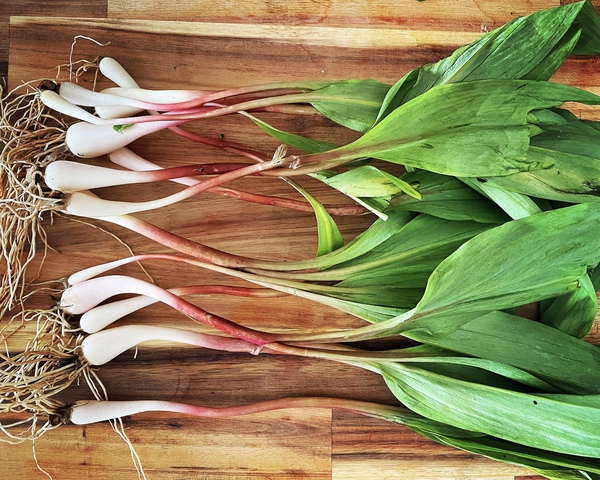Pasta with Ramps and Pancetta
_(1).jpg)
Finally – a ramp recipe that’s not pesto.
By Erin Henderson
I love May. It’s one of my favourite months for cooking. The first of the seasonal harvest: asparagus, fiddleheads, fava beans and ramps burst into spring with their verdant glory, and only weeks later disappear until next year.
I take full advantage. I cook daily with these fleeting vegetables, stuffing myself silly until I just can’t take it anymore. Asparagus tarts and soup, fiddlehead risotto, favas go into a Roman-inspired spring vegetable stew or top a ricotta smothered crostini…. But when it comes to ramps – the youthful, wild leeks found by intrepid foragers deep in Ontario’s forests – I come up bupkis. The only recipes ever proffered for these delicately flavoured alliums is pesto.
There’s only so much pesto I can eat. So I did what any bold cook would. I embarked on a Campbellian Hero’s Journey to find other ways to use ramps.
My culinary pilgrimage was justly rewarded as I discovered the below recipe on the James Beard website, written by New York restauranteur, and Anthony Bourdain mentor, Pino Luongo. I’ve adapted it slightly to fit my tastes, as I expect you will, as well. But it is a true and excellent dish to feature and celebrate ephemeral ramps.

Gnocchi with Ramps and Pancetta
Mr. Luongo uses bucatini pasta – a thick spaghetti-like pasta with a hole running through the centre like a straw – in this recipe, but I like it with ricotta gnocchi, which gives an extra layer of richness.
I have a big salt tooth, but find there is enough salt in the pancetta, stock, cheese, and the seasoned pasta water so I don’t add any extra. If you feel your dish needs some, season carefully when you add the wine.
Makes: About 8 servings
Chef level: Easy
Ingredients:
- 8 cups ricotta gnocchi (get the recipe here)
- 1 large bunch ramps
- ¼ cup extra virgin olive oil
- 150 g cubed pancetta
- 1 cup dry white wine, such as Sauvignon Blanc
- 2 cups chicken stock
- 2 Tbsp butter
- Juice of half a lemon
- Zest of 1 lemon
- Parmesan cheese, for grating
How to Make It:
- Soak the ramps in ice cold water and rinse well to get off the dirt.
- Slice the white portions into thin rounds and slice the green leaves, vertically, into long strips.
- Warm the olive oil over medium-low heat in a wide pan and add the pancetta, cooking until the meat softens and releases some fat, but doesn’t crisp, about 4 minutes.
- Add the sliced, white ramp roots and cook quickly, stirring often until they soften and become translucent, about 2-3 minutes.
- Add the wine and allow it to reduce to half, about 10 minutes.
- (Taste for seasoning and add a little salt if needed.)
- Once the wine has reduced, add the chicken stock and allow it to simmer, reduce slightly and thicken.
- Meanwhile, while this is happening, set up a large pot of water for the pasta and bring to a boil.
- Season with a handful of salt and add in your gnocchi.
- Once the gnocchi rise to the surface, use a slotted spoon or spider to scoop them into the sauce. Leave the pasta water on the stove.
- Add the reserved ramp greens, butter, and lemon zest, and stir to coat and cook through for about a minute.
- Add in the lemon juice and stir again.
- If your sauce looks dry, add some pasta water a tablespoon or so at a time, until it loosens to your liking.
- Spread the finished pasta onto a serving platter, sprinkle with parmesan cheese and serve.
Wine Pairing
The vegetal brightness the ramps and lemon bring to the dish, alongside the rich texture of the gnocchi and cheese makes me want a wine with herbal flavours to match, but with fresh acidity to lighten the robust weight of the pasta.
I like a simple Sauvignon Blanc for this. The fruit-forward versions from South Africa would be lovely here.
